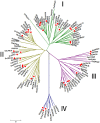Genome-wide survey and expression analysis of calcium-dependent protein kinase in Gossypium raimondii
- PMID: 24887436
- PMCID: PMC4041719
- DOI: 10.1371/journal.pone.0098189
Genome-wide survey and expression analysis of calcium-dependent protein kinase in Gossypium raimondii
Abstract
Calcium-dependent protein kinases (CDPKs) are one of the largest protein kinases in plants and participate in different physiological processes through regulating downstream components of calcium signaling pathways. In this study, 41 CDPK genes, from GrCPK1 to GrCPK41, were identified in the genome of the diploid cotton, Gossypium raimondii. The phylogenetic analysis indicated that all these genes were divided into four subgroups and members within the same subgroup shared conserved exon-intron structures. The expansion of GrCPKs family in G. raimondii was due to the segmental duplication events, and the analysis of Ka/Ks ratios implied that the duplicated GrCPKs had mainly undergone strong purifying selection pressure with limited functional divergence. The cold-responsive elements in promoter regions were detected in the majority of GrCPKs. The expression analysis of 11 selected genes showed that GrCPKs exhibited tissue-specific expression patterns and the expression of GrCPKs were induced or repressed by cold treatment. These observations would lay an important foundation for functional and evolutionary analysis of CDPK gene family in Gossypium species.
Conflict of interest statement
Figures





Similar articles
-
Genome-wide identification of the MIOX gene family and their expression profile in cotton development and response to abiotic stress.PLoS One. 2021 Jul 9;16(7):e0254111. doi: 10.1371/journal.pone.0254111. eCollection 2021. PLoS One. 2021. PMID: 34242283 Free PMC article.
-
Genome-wide identification and analysis of the aldehyde dehydrogenase (ALDH) gene superfamily of Gossypium raimondii.Gene. 2014 Oct 1;549(1):123-33. doi: 10.1016/j.gene.2014.07.054. Epub 2014 Jul 22. Gene. 2014. PMID: 25058695
-
Genome-wide investigation and transcriptome analysis of the WRKY gene family in Gossypium.Mol Genet Genomics. 2015 Feb;290(1):151-71. doi: 10.1007/s00438-014-0904-7. Epub 2014 Sep 5. Mol Genet Genomics. 2015. PMID: 25190108
-
Genome-Wide Analysis of Multidrug and Toxic Compound Extrusion (MATE) Family in Gossypium raimondii and Gossypium arboreum and Its Expression Analysis Under Salt, Cadmium, and Drought Stress.G3 (Bethesda). 2018 Jul 2;8(7):2483-2500. doi: 10.1534/g3.118.200232. G3 (Bethesda). 2018. PMID: 29794162 Free PMC article.
-
Analyses of the NAC transcription factor gene family in Gossypium raimondii Ulbr.: chromosomal location, structure, phylogeny, and expression patterns.J Integr Plant Biol. 2013 Jul;55(7):663-76. doi: 10.1111/jipb.12085. J Integr Plant Biol. 2013. PMID: 23756542
Cited by
-
Genome-wide survey and expression analysis of the calcium-dependent protein kinase gene family in cassava.Mol Genet Genomics. 2016 Feb;291(1):241-53. doi: 10.1007/s00438-015-1103-x. Epub 2015 Aug 14. Mol Genet Genomics. 2016. PMID: 26272723
-
Calcium-Dependent Protein Kinase GhCDPK28 Was Dentified and Involved in Verticillium Wilt Resistance in Cotton.Front Plant Sci. 2021 Dec 15;12:772649. doi: 10.3389/fpls.2021.772649. eCollection 2021. Front Plant Sci. 2021. PMID: 34975954 Free PMC article.
-
Genome-wide identification, molecular evolution and expression analysis of the B-box gene family in mung bean (Vigna radiata L.).BMC Plant Biol. 2024 Jun 12;24(1):532. doi: 10.1186/s12870-024-05236-9. BMC Plant Biol. 2024. PMID: 38862892 Free PMC article.
-
Genome-wide analysis of the IQD gene family in maize.Mol Genet Genomics. 2016 Apr;291(2):543-58. doi: 10.1007/s00438-015-1122-7. Epub 2015 Oct 9. Mol Genet Genomics. 2016. PMID: 26453258
-
Identification and expression analysis of TALE superfamily genes explore their key roles in response to abiotic stress in Brassica napus.BMC Plant Biol. 2024 Dec 23;24(1):1238. doi: 10.1186/s12870-024-05953-1. BMC Plant Biol. 2024. PMID: 39716059 Free PMC article.
References
-
- Yamaguchi-Shinozaki K, Shinozaki K (2006) Transcriptional regulatory networks in cellular responses and tolerance to dehydration and cold stresses. Annu Rev Plant Biol 57: 781–803. - PubMed
-
- Valliyodan B, Nguyen HT (2006) Understanding regulatory networks and engineering for enhanced drought tolerance in plants. Curr Opin Plant Biol 9: 189–195. - PubMed
-
- Tran LS, Nakashima K, Shinozaki K, Yamaguchi-Shinozaki K (2007) Plant gene networks in osmotic stress response: from genes to regulatory networks. Methods Enzymol 428: 109–128. - PubMed
-
- Evans NH, McAinsh MR, Hetherington AM (2001) Calcium oscillations in higher plants. Curr Opin Plant Biol 4: 415–420. - PubMed
Publication types
MeSH terms
Substances
LinkOut - more resources
Full Text Sources
Other Literature Sources

